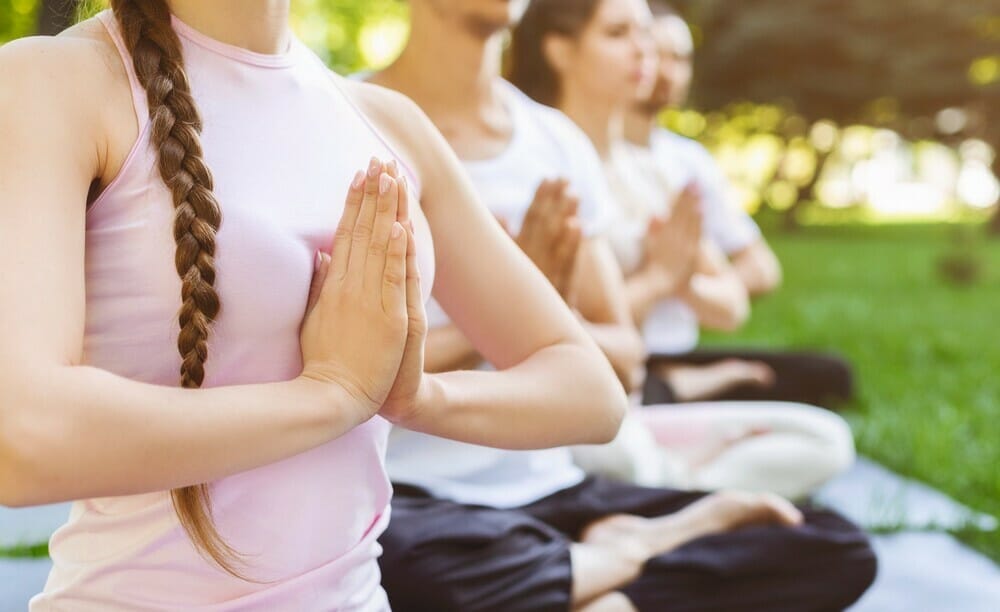What Is Namaste? & Benefits Of Using It
Have you ever been in a yoga class and noticed the teacher greeting everyone with Namaste?
Namaste is a word that comes from both Sanskrit (Namah + Asmi = “I bow to you”) and Hindi (नमस्ते). It is used in greeting and parting- a traditional form of prayer to show respect, love, and gratitude.
What does Namaste mean?
Namaste is the equivalent of hello, but with an element of respect. In reality, Namaste is not just a yoga word, according to Spiritual Science.
The practice of saying or bowing with hands together can be used as a greeting (in place of hello or goodbye), an acknowledgement, an expression of thankfulness, or even an indication that something is worth praise.
“The word can be cut into three sections: nama, as, and te, which means ‘I,’ ‘you,’ and ‘us,’ respectively.
The word can be used interchangeably with the words Namaskar (which means "I bow to you") and namaskriti (which means "the spirit of 'I'").
The spiritual meaning of Namaste.
The spiritual meaning of the word namaste is “the divine in me bows to thy divine” or “God is in me, and I am in you.”

Thus, when someone greets someone with the feeling that "I am paying homage to the soul in the other," a spiritual bond is formed between them.
Namaste creates vibrations to those receiving the gesture. The greeting Namaste creates a cycle of blissful energy that is given and received. The heart centres and chakras are said to be connected during the divine saying,
In a state of superconsciousness, your mind becomes centred in the bliss of your spine. You are one with all. You are free and clear of the ego.
You are all that is, and there is no separation. There is no thinking; there is only being. This place of being or soul space is your true essence, your Self or God Consciousness.
How is it pronounced?
Americans often mistakenly use the “a” sound to the vowels in words like “Nah-STAY.” They also tend to emphasize the last syllable.
Nonetheless, the word to pronounce Namaste is Na-mah-stay, using the English alveolar "th" sound [t] as in "thick." It is not pronounced Naa-mah-stay, with the alveolar lateral [n] sound as in "near" or nasal as in the word "namaste."
The last syllable might be unfamiliar to native English speakers. The “st” in Namaste is a little softer than the English pronunciation.
The tongue touches beyond the front teeth to create a sound that might be described as a clipped lisp.
When do we use Namaste?
Using Namaste at the end of a yoga class is somewhat baffling to some South Asians.
In my experience, living in India and with my family here in the United States, Namaste or Namaskar is said when I greet and meet elders, not when someone leaves.
But it’s not just a simple, “Hey there,” It’s rather formal.
In South Asian culture, it's most often used as a greeting of deep respect, reserved for elders, teachers, or other honourable people.
In this way, there’s a bit of hierarchy attached: Young people tend to use this to greet one another or elders. Students would typically address their teachers using this term.
Namaste in yoga.
Namaste is customary in yoga. It sends a message of peace to the universe with this gesture. The intention is to receive a positive message back in return. Most people typically use it to thank the teacher or say goodbye at the end of class.

In modern cultures, the meaning of Namaste is taken to a new level. It goes beyond a mere mental rationale and a traditional articulation.
For example, some yogis in India do not use the word namaste, but it is received as a greeting of endearment in Western cultures. In essence, Namaste is to recognize that we are all equal.
Many people are often confused about the meaning of Namaste, and they refer to it as a simple greeting. For example, a common misperception is that Namaste is used to finish a class.
However, the true meaning is to bow down in prayer with love and honour from your soul to another’s.
Namaste stems from respecting all people as equal. It is honouring your teacher or yourself that connects you with the higher power that connects us all.
The bowing and honour within this word bring about a feeling of unity for us all. There is nothing better than ending a yoga session with accepting our similarities rather than focusing on our differences as one big community without judgment or bias.
How to make the Namaste gesture?

To make a Namaste gesture, you press your hands together in front of the chest like in prayer; expressing reverence or thanks. You can use your palms, fingers, or fingertips when pressing your hands together.
The traditional way of making the namaste gesture is by using your hands only. No thumbs are used: it is considered disrespectful.
There are a few things you should remember when you make this gesture yourself:
- The hands are pressed together before your chest
- This is not a hand prayer; you should not bow your head or close your eyes, just look forward at all times.
- The left hand is draped over the right hand to touch the palms, and the index fingers touch each other and point upwards in a “V” shape. The chin rests on the top of the folded hands.
What’s the difference between Namaskar and Namaste?
Namaste and Namaskar are interchangeable in many cases. Both are employed to greet and honour an esteemed person—the word Namaskar can be used to greet someone influential, revered respectfully, and spiritually significant.
“Considering that when you do a sun salutation—Surya Namaskar—you are respectfully greeting the sun.”
Final Thoughts
By understanding the true meaning of Namaste, you can use it as a tool to live your life with love and respect.
Remember that the next time you say "Namaste" to someone else, this can be another way of saying, "I see God/the Divine in you."
The gesture is prayer-like, and it signifies the abundance of love around us.
Namaste is one of the most common words used in yoga. Namaste is always said to or by another person. It is never a statement (although it can be used as one).
Instead, Namaste is an affirmation of the holistic nature of life.
Studying the word and its significance will bring a deep feeling of respect for yourself, others, and the world itself. You should be reminded every day to always look beyond the superficial.
Look beyond what you may think or see at first glance. There is more to this world than meets the eye; it just takes a deeper look or more profound thought to find it.
I hope this article helped you to understand the meaning of Namaste better. Have a wonderful day!







